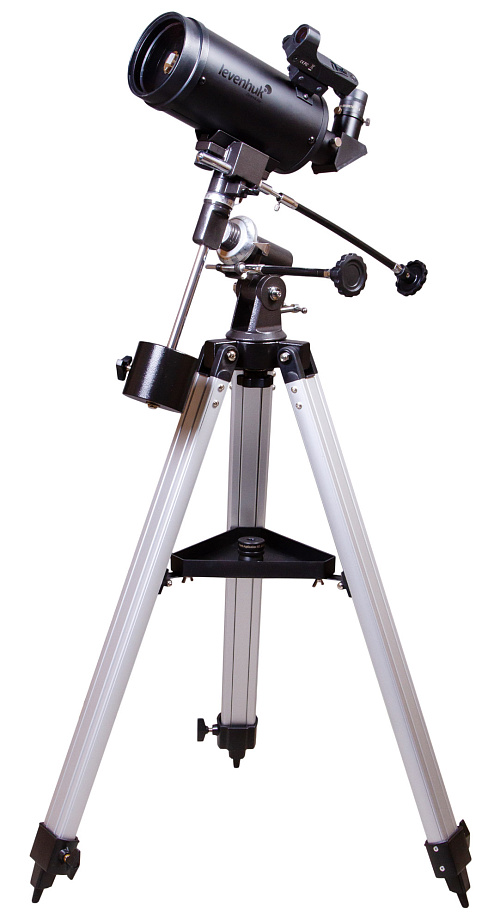Levenhuk Skyline PLUS 90 MAK Telescope
Maksutov-Cassegrain. Aperture: 90mm. Focal length: 1250mm
| Product ID | 74372 |
| Brand | Levenhuk, Inc., USA |
| Warranty | lifetime |
| EAN | 5905555002231 |
| Package size (LxWxH) | 82x35x23 |
| Shipping Weight | 9.28 |
The Levenhuk Skyline PLUS 90 MAK Telescope is a compact optical tool for exploring outer space and the deep sky. It is excellent for users with little experience in astronomy but who are ready to move to more complex tasks. It is a rather simple-to-use telescope but it has more advanced functionality than the entry-level models. It is suitable for observing the Moon, planets all the way to Saturn, and their large satellites. As for the far limits of the solar system, they are discernible but without much detail. You can observe the brightest objects from the NGC catalog, double stars, all of the objects from the Messier catalog, and planetary and diffuse nebulae.
The telescope uses a catadioptric scheme and, therefore, it is small and lightweight, and it features perfect optical capabilities. Due to fully multi-coated optics, this catadioptric telescope gathers much light, which allows for observing dim stars and other dim objects in the night sky. The kit includes two eyepieces that provide average magnification. A diagonal mirror is used for observing terrestrial landscapes: It won’t be convenient to conduct observations without it.
An equatorial mount means that the accurate tracking of astronomical objects across the sky requires less effort. These celestial objects do not “run away” even during long observations. The mount is attached to an aluminum tripod that also has a stable and durable accessory tray. The height of each tripod leg is adjusted individually so that the telescope can be placed on almost any surface.
Features:
- Catadioptric telescope on an equatorial mount
- Fully multi-coated optics
- Two eyepieces and a diagonal mirror are included in the kit
- Sturdy aluminum mount with an accessory tray
- A great choice for beginner users
The kit includes:
- Telescope optical tube
- Equatorial mount
- Aluminum tripod with an accessory tray
- Red Dot finderscope
- 10mm eyepiece, 125x
- 20mm eyepiece, 62.5x
- 90° diagonal mirror
- Slow-motion control knobs
- Counterweight
- User manual and lifetime warranty
| Product ID | 74372 |
| Brand | Levenhuk, Inc., USA |
| Warranty | lifetime |
| EAN | 5905555002231 |
| Package size (LxWxH) | 82x35x23 |
| Shipping Weight | 9.28 |
| Optical design | catadioptric |
| Optical scheme | Maksutov-Cassegrain |
| Optics material | optical glass |
| Optics coating | fully multi-coated |
| Primary mirror diameter (aperture), mm | 90 |
| Focal length, mm | 1250 |
| Highest practical power, x | 180 |
| Aperture ratio | f/12.5 |
| Limiting stellar magnitude | 11.87 |
| Eyepieces | 10mm (125x), 20mm (62.5x) |
| Eyepiece barrel diameter, in | 1.25 |
| Finderscope | red dot |
| Focuser | threaded |
| Tripod | aluminum |
| Tripod height (adjustable), mm | 710–1230 |
| Accessory tray | ✓ |
| Telescope control | manual |
| Mount | equatorial, EQ1 |
| Counterweight weight, kg | 2.2 |
| Power supply | CR2032 type battery – 1 pc. (not included) |
| Optical tube mounting mode | mounting plate |
| Dovetail mount | ✓ |
| Optical tube material | steel |
| User level | beginners, experienced users |
| Assembly and installation difficulty level | complicated |
| Observed object | planets of the Solar System and deep-sky objects |
Convenient diagrams that describe how to install additional accessories on refractors and catadioptric telescopes
Find out how to assemble a telescope on an example of the Levenhuk Skyline 90x900 EQ telescope
This short guide will help you avoid typical mistakes and learn more about telescope and mounting types
The basics of astronomical observations for beginners
In this article we have gathered answers to some of the most frequently asked questions about telescopes
The most interesting celestial objects you can observe with Levenhuk telescopes
How telescopes work?
You can actually perform observations from your balcony!
All about telescope sizes, types, magnification, and mounts
Learn how to set up and use the telescope properly
Astronomy in light-polluted skies. Find out what you can observe in the city
Read an interesting comprehensive article on telescopes for little astronomers
The pictures are made with Levenhuk telescopes
Celestial objects you can observe with telescopes of different apertures
Colored and vivid images of galaxies, planets and star clusters entrance everyone who is fascinated by boundless space
Find an interesting review on the history of the changes to a refracting telescope
To make the process of choosing a telescope easier, we will tell you about the characteristics of the most popular types of telescopes today
Learn everything you need to know about refractor telescopes to make the right choice


















